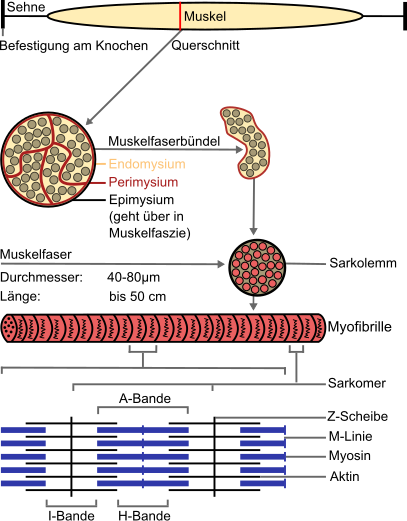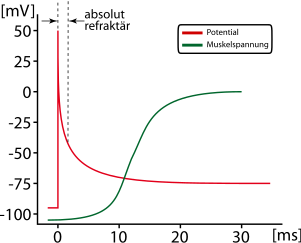Skeletal muscle
When skeletal muscles applies to those muscles that are primarily responsible for the voluntary, active body movements, such as the movement of arms and legs. The skeletal muscles, like the heart muscles, belong to the striated muscles . In contrast, muscles of this type are also found in the tongue , face (facial muscles ), in the muscles of the larynx and in the muscles of the diaphragm , although their task is not to move the skeleton. In contrast to the other striated muscles, the heart muscle is not subject to arbitrary control.
The skeletal muscles can be divided into “red” and “white” muscles. The red muscles , which owe their red color to a higher content of muscle fibers with oxidative energy generation, are more responsible for endurance movements (i.e. predominate in endurance athletes). The white muscles can contract faster and perform stronger movements (in other words, they form a significant part of the muscle mass in strength athletes).
The skeletal muscles are attached to the skeleton by tendons or fasciae . Accordingly, a distinction is made between origin and insertion , with the muscle belly in between.
construction


A skeletal muscle consists of several muscle fiber bundles, each of which consists of individual muscle fibers that can be up to 15 cm long (in the tailor 's muscle of the thigh even up to 30 or even 40 cm) and are enveloped on the outside by connective tissue , the fascia . A skeletal muscle is surrounded in its entirety by connective tissue ( epimysium ), from which so-called septa pull into the interior, enveloping the individual muscle fibers ( endomysium ) and groups of muscle fibers into muscle fiber bundles ( perimysium ).
Each muscle fiber is made up of thousands of thread-like structures called myofibrils . These run through the length of the muscle fibers next to each other and are made up of smaller units, the myofilaments . In these protein structures, muscle contraction occurs through mutual pushing into one another. The arrangement of the myofilaments in the sarcomere causes the microscopically visible transverse stripes of the muscle fibers.
The smooth muscles , which are responsible for the involuntary movements of the gastrointestinal tract , the expansion of the blood vessels, etc., must be distinguished from the skeletal muscles .
Influence on physical well-being
The skeletal muscles can influence the immune system , lipid metabolism and the development of diabetes mellitus via messenger substances .
See also
Web links
- Learning tables for all skeletal muscles (Dr. Jastrow)
- Electron microscopic images (Dr. Jastrow's EM Atlas)
Individual evidence
- ↑ Robert Thielicke: Strong piece. In: Focus , April 21, 2008.
- ↑ Biceps, Triceps & Co. - How our muscles influence our lives. In: 3sat , August 8, 2014.


